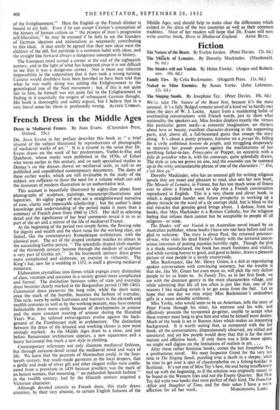French Dress in the Middle Ages
DR. JOAN EVANS in her preface describes this book as " a brief résumé of the subject illustrated by reproductions of photographs of mediaeval works of art." It is a résumé in the sense that Dr.
Evans draws on the work of her predecessors, Viollet-le-Duc and Quicherat, whose works were published in the 1870s, of Enlart who wrote earlier in this century, and on such specialised studies as Demay's on the dresses shown on mediaeval seals, as well as on published and unpublished contemporary documents. The dates of these earlier works, which are still invaluable in the study of the subject, are sufficient to show the need for a volume which can add the resources of modern illustration to an authoritative text.
This account is beautifully illustrated by eighty-four plates from photographs of sculpture, paintings, manuscript-illustrations and tapestries. Its eighty pages of text are a straightforward narrative of ease, clarity and impeccable scholarship ; but the author's deep knowledge and understanding of the period make it more than a summary of French dress from 1060 to 1515. Her skill in selecting detail and the significance of her brief comments reveal it to us as part of the art and a mirror of the life of mediaeval France. At the beginning of the period two simple forms, the flowing robe for dignity and wealth and the short tunic for the working class, are linked, like the contemporary Romanesque architecture, with the classical past. The art of the draped costume reaches its climax in the succeeding Gothic period. " The splendidly draped cloth mantles of the thirteenth century become through the medium of sculpture a very part of Gothic art." In the fourteenth century dress grows more complicated and elaborate, an exercise in virtuosity. The King's hat, new for a wedding in 1352, is itself a glowing mediaeval miniature.
Elaboration crystallises into forms which expr%s every distinction of class, vocation and occasion in a society grown more complicated and formal. The distinction between robes of state and everyday dress becomes clearly marked in the Burgundian period (1380-1461). Ceremonial dress preserves the long robe, while the short tunic, once the mark of the humble, becomes the fashion of everyday. This style, worn by noble huntsmen and warriors in the eleventh and twelfth centuries as well as by the working peasant, may have entered fashionable dress more easily because of developments in armour and the more constant wearing of armour during the Hundred Years War. Its tailored extravagances evolve against the back- ground of the Flamboyant style in architecture. The distinction between the dress of the leisured and working classes is now most strongly marked. As the Middle Ages draw to a close, and just before Renaissance architecture appears, a new squareness and a heavy horizontal line mark a new style in clothing.
Contemporary references not only illustrate mediaeval fashions, -but through costume-detail reveal the mediaeval mind and ways of life. We learn that the peasants of Montauban could, in the four- teenth century, buy ready-made garments at the local drapers, that a girdle and studs of silver gilt and other elegant trifles were confis- cated from a prostitute in 1459 because jewellery was the mark of an honest woman, that mourning, " an outlandish Spanish fashion " in the twelfth century, had by the fifteenth century acquired a Victorian character.
Although devoted entirely to French dress, this study draws attention, by their very absence, to certain English fashions of the Middle Ages, and should help to make clear the differences which existed in the dress of the two countries as well as their common tradition. Most of her readers will hope that Dr. Evans will now write another book, Dress in Mediaeval England. ANNE BUCK.


































 Previous page
Previous page